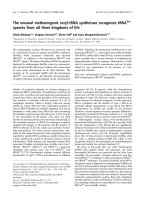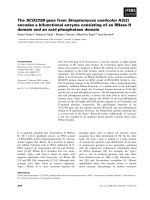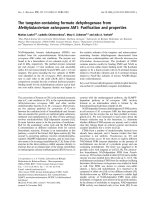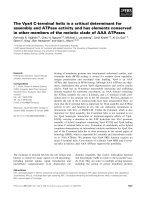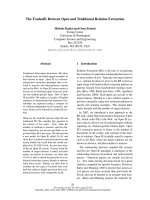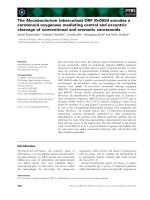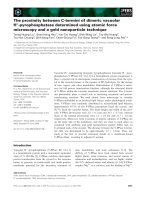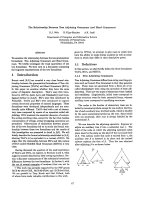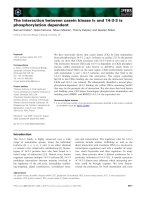báo cáo khoa học: "The relationship between baseline Organizational Readiness to Change Assessment subscale scores and implementation of hepatitis prevention services in substance use disorders treatment clinics: a case study" pdf
Bạn đang xem bản rút gọn của tài liệu. Xem và tải ngay bản đầy đủ của tài liệu tại đây (656.36 KB, 12 trang )
Implementation
Science
Hagedorn and Heideman Implementation Science 2010, 5:46
/>Open Access
RESEARCH ARTICLE
© 2010 Hagedorn and Heideman; licensee BioMed Central Ltd. This is an Open Access article distributed under the terms of the Creative
Commons Attribution License ( which permits unrestricted use, distribution, and repro-
duction in any medium, provided the original work is properly cited.
Research article
The relationship between baseline Organizational
Readiness to Change Assessment subscale scores
and implementation of hepatitis prevention
services in substance use disorders treatment
clinics: a case study
Hildi J Hagedorn*
1,2,3
and Paul W Heideman
4
Abstract
Background: The Organizational Readiness to Change Assessment (ORCA) is a measure of organizational readiness for
implementing practice change in healthcare settings that is organized based on the core elements and sub-elements
of the Promoting Action on Research Implementation in Health Services (PARIHS) framework. General support for the
reliability and factor structure of the ORCA has been reported. However, no published study has examined the utility of
the ORCA in a clinical setting. The purpose of the current study was to examine the relationship between baseline
ORCA scores and implementation of hepatitis prevention services in substance use disorders (SUD) clinics.
Methods: Nine clinic teams from Veterans Health Administration SUD clinics across the United States participated in a
six-month training program to promote evidence-based practices for hepatitis prevention. A representative from each
team completed the ORCA evidence and context subscales at baseline.
Results: Eight of nine clinics reported implementation of at least one new hepatitis prevention practice after
completing the six-month training program. Clinic teams were categorized by level of implementation-high (n = 4)
versus low (n = 5)-based on how many hepatitis prevention practices were integrated into their clinics after
completing the training program. High implementation teams had significantly higher scores on the patient
experience and leadership culture subscales of the ORCA compared to low implementation teams. While not reaching
significance in this small sample, high implementation clinics also had higher scores on the research, clinical
experience, staff culture, leadership behavior, and measurement subscales as compared to low implementation clinics.
Conclusions: The results of this study suggest that the ORCA was able to measure differences in organizational factors
at baseline between clinics that reported high and low implementation of practice recommendations at follow-up.
This supports the use of the ORCA to describe factors related to implementing practice recommendations in clinical
settings. Future research utilizing larger sample sizes will be essential to support these preliminary findings.
Background
Experts in organizational change contend that organiza-
tional readiness to change is critical to successful imple-
mentation of new practices [1-5]. However, as pointed
out in a review by Weiner et al. [6], health services
researchers have only just begun theorizing about and
developing measures of organizational readiness to
change. Weiner and colleagues reviewed the conceptual-
ization and measurement of organizational readiness to
change, drawing from not only health services research
but also business, education, and human services jour-
nals. The basic conclusions of the review were that there
is little consistency in conceptual terminology regarding
organizational readiness to change, and most currently
* Correspondence:
1
Substance Use Disorders Quality Enhancement Research Initiative,
Minneapolis VA Medical Center, Minneapolis, MN, USA
Full list of author information is available at the end of the article
Hagedorn and Heideman Implementation Science 2010, 5:46
/>Page 2 of 12
available instruments for measuring the construct have
limited evidence of reliability and validity. Particularly
lacking is evidence that measures of organizational readi-
ness to change can predict organizational-level outcomes.
The authors cite only four such studies [7-10], with three
being from the business rather than the healthcare sector.
These studies used surveys that assessed readiness to
change and outcomes simultaneously. None of these
studies examined whether organizational readiness to
change is related to actual future implementation of new
practices. Two additional recent studies assessed the abil-
ity of an organizational readiness to change measure to
predict organization-level outcomes [11,12]; one retro-
spectively assessed non-adoption of a new technology
[11], and the other offered a qualitative description of the
relationship between organizational readiness to change
and implementation outcomes [12]. In healthcare, with
its current heavy focus on interventions designed to
implement evidence-based practices, what is sorely
needed is a measure that demonstrates a correlation to
actual uptake of new practices following such interven-
tions. Such a measure could provide insight into the like-
lihood of successful implementation within a particular
site prior to the investment of resources or could allow
tailoring of an implementation intervention to the spe-
cific needs of participating sites. In addition to the defi-
ciencies in the construct definition and measurement of
organizational readiness to change reported by Weiner et
al. [6], the lack of evidence supporting the correlation of
measures of organizational readiness to change with
implementation intervention outcomes can be added to
the list of deficiencies in the field as it currently stands.
The Organizational Readiness to Change Assessment
(ORCA)
The ORCA is an instrument that was developed by the
Veterans Administration's (VA) Ischemic Heart Disease
Quality Enhancement Research Initiative for assessing
organizational readiness for implementation of evidence-
based healthcare interventions [13,14]. A significant
strength of the ORCA is that it was developed based on
the Promoting Action on Research Implementation in
Health Services (PARIHS) model, a conceptual frame-
work that has shown promise in guiding implementation
efforts in healthcare [15-17]. Helfrich and colleagues
examined the psychometrics of the ORCA using cross-
sectional data from three quality improvement projects
conducted in VA medical centers [14]. Psychometric
analyses indicated general support for the reliability of
ORCA items and for the three primary scales of the
ORCA [14]. Factor analyses supported a three-factor
structure as hypothesized by the PARIHS framework. In
addition to being model-driven and having promising
psychometric properties, the ORCA fits many of the rec-
ommendations found in the Weiner review regarding
defining and measuring the construct of organizational
readiness to change [6]. The ORCA measures readiness
to change at the organizational level and focuses the
respondent on a specific change referent rather than
innovation in general. It is designed to be used after an
organization has agreed to adopt a change but prior to
the start of implementation efforts. The ORCA assesses
aspects of both willingness of respondents to adopt the
new practice (e.g., agreement with the evidence, innova-
tive culture) and capability to implement change (e.g.,
available resources, leadership effectiveness). The ORCA
measures not only whether resources are available to the
organization, but whether the respondents perceive that
those resources will be made available for the intended
change.
For these reasons, the ORCA seems to have potential as
a robust measure of organizational readiness to change.
However, no research to date has addressed the predic-
tive validity of the ORCA scales. Specifically, it is not
known whether the ORCA scales predict outcomes in
implementation projects.
The current study
The present study aimed to assess whether higher levels
of pre-training organizational readiness, operationalized
as higher scores on the ORCA scales, were related to
greater implementation of hepatitis prevention practices
following completion of the Liver Health Initiative (LHI)
training program.
Methods
Teams from VA substance use disorders (SUD) clinics
voluntarily enrolled in the 2007 LHI training program by
responding to advertisements on the VA national addic-
tions email group and on the VA quarterly SUD national
conference calls. The advertisements stated that the clini-
cal team should include a member of the SUD clinic lead-
ership (i.e., medical director, program coordinator, chief
nurse, et al.), one frontline SUD provider interested in
integrating hepatitis services into SUD treatment, and
one frontline hepatitis clinician.
Overall, 11 clinic teams from across the United States
responded and were enrolled in the LHI training pro-
gram. Two of the clinic teams did not provide follow-up
data on implementation outcomes and therefore were
excluded from the current study. The sample for the cur-
rent study includes nine teams. One of the teams did not
provide baseline ORCA context scale responses so com-
parisons of context scale scores to implementation out-
comes include only eight teams. Clinic demographics, the
ORCA, and baseline implementation of hepatitis preven-
Hagedorn and Heideman Implementation Science 2010, 5:46
/>Page 3 of 12
tion services were collected by paper and pencil survey
from each team leader six weeks prior to attending the
face-to-face portion of the training. Team demographics
were collected from registration and attendance records
for the face-to-face portion of the training. Facility demo-
graphics were collected from VA public databases. Imple-
mentation outcomes were collected by paper and pencil
survey from each team leader one, three, and six months
after completing the face-to-face portion of the training
program.
Overview of the LHI
The LHI is sponsored by the VA SUD Quality Enhance-
ment Research Initiative and Hepatitis C Resource Cen-
ter. The goal of the LHI is to improve prevention,
identification, and treatment of hepatitis among patients
seeking treatment at VA SUD clinics. Specific goals of the
LHI are based on a successful Healthy Liver program
established in the Minneapolis VA Medical Center's
Addictive Disorders Service [18]. The program trains
substance use disorder clinics to provide: testing for hep-
atitis B and C and immunities to hepatitis A and B; com-
prehensive patient education on hepatitis infections and
liver health; hepatitis A and B immunizations; and expe-
dited referrals to hepatitis treatment providers for
patients diagnosed with hepatitis B or hepatitis C. Teams
participating in the LHI training program complete a
baseline needs assessment that provides the team with a
basis for the later development of their action plan.
Teams then attend a 1.5-day training at the Minneapolis
VA Medical Center. The first day of training provides
information on the risks for and impact of liver disease in
patients with SUD, the goals of the LHI, and a quality
improvement process for implementing the LHI goals.
The remaining half-day of the training assists teams in
development of action plans facilitated via an Action Plan
form that lists the recommendations of the LHI and asks
teams to identify specific improvement goals and action
steps. Action plans are then presented to the rest of the
trainees and the program faculty for feedback. To support
progress on improvement goals and actions steps, exter-
nal facilitation is provided via telephone for six months.
Measures
Team, clinic, and facility demographics
Team information included the number of team mem-
bers attending and their job titles. Clinic demographics
included the number of full-time equivalent staff mem-
bers in the SUD clinic, the average number of new patient
intakes completed each month, and the total number of
current patients receiving services at the clinic.
Facility demographics included facility type (medical
center versus community-based outpatient clinic) and
facility complexity level. Every VA medical center is
assigned to a complexity level group based on the VA's
2005 Facility Complexity Model. The model employs sev-
eral variables, including the total number of patients
served by the facility, the number and types of intensive
care units in the facility, the number of resident programs
and the total number of resident slots available, the total
amount of research dollars managed by a facility, and the
number and breath of physician specialists employed by
the facility. The model uses a hierarchical clustering
method to assign each medical center to a group. This
method of grouping hospitals was based on work by Baz-
zoli and her colleagues [19,20] but the specific variables
used for grouping hospitals were revised to maximize rel-
evance specifically to VA medical centers. Based on the
algorithm, each medical center receives a score of 1 (high
complexity), 2 (medium complexity), or 3 (low complex-
ity). Because one-half of all VA medical centers are high
complexity, the group receiving scores of 1 is further
divided into sub-categories of 1A, 1B, and 1C, with 1A
representing the highest level of complexity followed by
1B and 1C.
Organizational Readiness to Change Assessment (ORCA)
The ORCA is a 77-item scale designed to measure the
elements and sub-elements of the PARIHS model that are
theorized to be related to successful implementation out-
comes. The ORCA consists of three scales corresponding
to the three PARIHS model primary elements: strength
and extent of evidence for clinical practice changes [21];
quality of the organizational context [22]; and capacity for
internal facilitation [23]. The evidence scale consists of
four subscales. The first subscale is comprised of two
items that assess the discrepancy between the respon-
dent's opinion of the strength of evidence base and the
opinion of their colleagues. The remaining three sub-
scales are research evidence, clinical experience, and
patient preferences, reflecting sub-elements of the
PARIHS evidence element. The context scale contains six
subscales: two assess aspects of organizational culture
(leadership culture and staff culture); one represents
leadership practices; one assesses measurement (e.g.,
leadership feedback); one assesses readiness to change
among opinion leaders; and one subscale examines
resources to support general practice changes. Capacity
for internal facilitation has nine subscales: two examining
senior leadership characteristics; five examining imple-
mentation of various organization characteristics such as
planning and progress; one measuring clinical champion
characteristics such as carrying out a project; and one
measuring communication. See Table 1 for the ORCA
items corresponding to each scale and subscale. Each
sub-scale consists of three to six items. All items are
scored on a 1 to 5 Likert scale with anchors of 1 =
strongly disagree and 5 = strongly agree. Scale and sub-
Hagedorn and Heideman Implementation Science 2010, 5:46
/>Page 4 of 12
Table 1: Organizational readiness to change assessment items
Scale Sub-Scale Items
Evidence* Research The proposed practice changes or guideline implementation:
Are(is) supported by RCTs or other scientific evidence from the VA.
Are(is) supported by RCTs or other scientific evidence from other healthcare systems.
Should be effective, based on current scientific knowledge.
Are(is) experimental, but may improve patient outcomes.
Likely won't make much difference in patient outcomes**.
Clinical Experiences The proposed practice changes or guideline implementation:
Are supported by clinical experience with VA patients.
Are supported by clinical experience with patients in other healthcare systems.
Conform to the opinions of clinical experts in this setting.
Have not been attempted in this setting**.
Patient Preferences The proposed practice changes or guideline implementation:
Have been well-accepted by VA patients in a pilot study.
Are consistent with clinical practices that have been accepted by VA patients.
Take into consideration the needs and preferences of VA patients.
Appear to have more advantages than disadvantages for VA patients.
Context Leadership Culture Senior leadership/clinical management in your organization:
Reward clinical innovation and creativity to improve patient care.
Solicit opinions of clinical staff regarding decisions about patient care.
Seek ways to improve patient education and increase patient participation in treatment.
Staff Culture Staff members in your organization:
Have a sense of personal responsibility for improving patient care and outcomes.
Cooperate to maintain and improve effectiveness of patient care.
Are willing to innovate and/or experiment to improve clinical procedures.
Are receptive to change in clinical processes.
Leadership Senior leadership/clinical management in your organization:
Provide effective management for continuous improvement of patient care.
Clearly define areas of responsibility and authority for clinical managers and staff.
Promote team building to solve clinical care problems.
Promote communication among clinical services and units.
Measurement Senior leadership/clinical management in your organization:
Provide staff with information on VA performance measures and guidelines.
Establish clear goals for patient care processes and outcomes.
Provide staff members with feedback/data on effects of clinical decisions.
Hold staff members accountable for achieving results.
Opinion Leaders Opinion leaders in your organization:
Believe that the current practice patterns can be improved.
Encourage and support changes in practice patterns to improve patient care.
Are willing to try new clinical protocols.
Hagedorn and Heideman Implementation Science 2010, 5:46
/>Page 5 of 12
Work cooperatively with senior leadership/clinical management to make appropriate
changes.
Resources In general in my organization, when there is agreement that change needs to happen:
We have the necessary support in terms of budget or financial resources.
We have the necessary support in terms of training.
We have the necessary support in terms of facilities.
We have the necessary support in terms of staffing.
Facilitation Leaders' Practices Senior leadership/clinical management will:
Propose a project that is appropriate and feasible.
Provide clear goals for improvement in patient care.
Establish a project schedule and deliverables.
Designate a clinical champion(s) for the project.
Clinical Champion The project clinical champion:
Accepts responsibility for the success of this project.
Has the authority to carry out the implementation.
Is considered a clinical opinion leader.
Works well with the intervention team and providers.
Leadership Implementation Roles Senior leadership/clinical management/staff opinion leaders:
Agree on the goals for this intervention.
Will be informed and involved in the intervention.
Agree on adequate resources to accomplish the intervention.
Set a high priority on the success of the intervention.
Implementation Team Roles The implementation team members:
Share responsibility for the success of this project.
Have clearly defined roles and responsibilities.
Have release time or can accomplish intervention tasks within their regular work load.
Have staff support and other resources required for the project.
Implementation Plan The implementation plan for this intervention:
Identifies specific roles and responsibilities.
Clearly describes tasks and timelines.
Includes appropriate provider/patient education.
Acknowledges staff input and opinions.
Project Communication Communication will be maintained through:
Regular project meetings with the project champion and team members.
Involvement of quality management staff in project planning and implementation.
Regular feedback to clinical management on progress of project activities and resource
needs.
Regular feedback to clinicians on effects of practice changes on patient care/outcomes.
Project Progress Tracking Progress of the project will be measured by:
Collecting feedback from patients regarding proposed/implemented changes.
Collecting feedback from staff regarding proposed/implemented changes.
Developing and distributing regular performance measures to clinical staff.
Table 1: Organizational readiness to change assessment items
(Continued)
Hagedorn and Heideman Implementation Science 2010, 5:46
/>Page 6 of 12
scale scores are calculated by dividing the total score by
the number of items on the scale resulting in scale score
values of 1 to 5.
Team leaders completed the ORCA six weeks prior to
attending the face-to-face portion of the training pro-
gram. For the purpose of this study, only the evidence and
context scale items were completed by the team leaders.
The current study did not examine the facilitation scale
because the items in that scale assess material that was
not applicable before completing the 1.5-day training and
developing an action plan (e.g., questions regarding the
implementation plan, the role of the implementation
team, et al.).
Assessment of baseline implementation and
implementation outcomes
At baseline (six weeks prior to the face-to-face portion of
the training program) and at one, three, and six months
after completing the face-to-face training, team leaders
completed a survey evaluating their clinic's current prac-
tices related to hepatitis screening, education, preven-
tion, and treatment referral. Questions on the survey
asked team leaders to report whether their clinic pro-
vided routine hepatitis B and C testing to new clients and
whether their clinic provided routine testing for immu-
nity to hepatitis A and B. If testing was provided in the
clinics, team leaders were asked to report what proce-
dures were in place to provide feedback of test results to
clients and what procedures were in place to refer clients
who tested positive for hepatitis B or C for care. Team
leaders were also asked whether vaccinations for hepatitis
A and B were available in their clinic. Finally, they were
asked to report whether they provided education regard-
ing hepatitis infections in their clinic and if they did,
which clients were targeted for this education (e.g., all or
only those in a specific program such as an intensive out-
patient program or a methadone program). The LHI
training program specifically recommends eight practices
for hepatitis prevention and care in SUD clinics, which
are summarized in Appendix 1. The team leaders' survey
responses were compared to the eight LHI practice rec-
ommendations, and the clinic received one point for each
practice that was currently in place. 'Implementation
scores' could therefore range from 0 to 8 depending on
current clinic practices, with higher scores reflecting
greater implementation of recommended practices.
Team leaders from all nine clinics completed the base-
line survey. Team leaders from eight clinics completed
the one-month survey. Three-month surveys were also
completed by eight team leaders. Only four team leaders
completed the six-month survey. A decision was made to
use the latest follow-up available for each clinic as the
best assessment of their final state of implementation
progress. Therefore, implementation outcome was based
on one-month follow-up data for one clinic, three-month
data for four clinics, and six-month data for four clinics.
Based on a median split of implementation scores at the
final follow-up, clinics who reported utilizing at least six
of the eight recommended practices were classified as
having high implementation of LHI recommendations (n
Providing a forum for presentation/discussion of results and implications for continued
improvements.
Project Resources The following are available to make the selected plan work:
Staff incentives.
Equipment and materials.
Patient awareness/need.
Provider buy-in.
Intervention team.
Evaluation protocol.
Project Evaluation Plans for evaluation and improvement of this intervention include:
Periodic outcome measurement.
Staff participation/satisfaction survey.
Patient satisfaction survey.
Dissemination plan for performance measures.
Review of results by clinical leadership.
* The Evidence questions are preceded by a statement identifying the evidence-based practice that is the current target of intervention.
** Denotes items that are reverse coded.
Table 1: Organizational readiness to change assessment items
(Continued)
Hagedorn and Heideman Implementation Science 2010, 5:46
/>Page 7 of 12
Table 2: Team/clinic demographics and baseline and follow-up implementation scores
Site ID Team Members* Facility Type Complexity
Level***
Staffing (FTE) † Intakes per
Month ††
Total Patient
Census †††
Implementation Scores Final
Implementation
Category
Baseline Month 1 Month 3 Month 6
1 CNS CBOC** N/A 4.5 3 58 4 6 7 - (missing data) High
2 RN Medical Center 1A 5.5 10 - 1 - 3 - Low
3 CSW, CNS, PA, NP Medical Center 1B 20.5 8 447 2 4 4 5 Low
4 NP, RN Medical Center 1A 20 80 65 7 6 8 - High
5 NP, MD Medical Center 1C 8 - 165 2 6 6 6 High
6 CSW Medical Center 2 21 30 227 3 4 - - Low
7CNS, RNMedical Center3 6 - - 556 5 Low
8AT, NPMedical Center2 11 40 40 677 - High
9 CNS, NP Medical Center 1B 9 40 142 2 2 2 3 Low
*CNS = Clinical Nurse Specialist; RN = Registered Nurse; CSW = Clinical Social Worker; PA = Physician's Assistant; NP = Nurse Practitioner; MD = Medical Doctor; AT = Addiction Therapist
**CBOC = Community-Based Outpatient Clinic
*** 1 = High Complexity (A representing highest level in this category followed by B and C); 2 = Medium Complexity; 3 = Low Complexity
† FTE = Full-Time Equivalent
†† Average number of new patients seen in one month.
††† Total number of patients receiving any services from the clinic at the time of baseline.
Hagedorn and Heideman Implementation Science 2010, 5:46
/>Page 8 of 12
= 4) and those who reported 5 or fewer practices were
classified as having low implementation of LHI recom-
mendations (n = 5).
Data analysis
Mean ORCA subscale scores were calculated for high
implementation clinics (defined as clinics receiving an
implementation score of 6 or greater at the final follow-
up available) and low implementation clinics (defined as
clinics receiving an implementation score of 5 or less at
the final follow-up available). Because of the small sample
size, the magnitude of the difference in mean ORCA sub-
scale scores between high and low implementation clinics
was evaluated using effect sizes (Cohen's d) and 95% con-
fidence intervals rather than employing tests for statisti-
cally significant differences.
Results
Demographics
See Table 2 for specific clinic demographics. The nine
participating SUD clinic teams ranged in size from one to
four members. Team members included five nurse practi-
tioners, four clinical nurse specialists, three registered
nurses, two clinical social workers, one physician, one
addiction therapist, and one physicians' assistant. Of the
nine clinic teams, eight were from SUD clinics that
resided within VA medical centers and one was from a
VA community-based outpatient clinic. Of the eight
teams from medical centers, five came from high com-
plexity medical centers, two came from medium com-
plexity centers, and one came from a low complexity
center. The number of full-time equivalent staff assigned
to each clinic ranged from 4.5 to 21. The average number
of new patients served each month ranged from 3 to 80.
The total number of patients currently receiving services
ranged from 40 to 447.
Implementation of LHI recommendations
Refer to Table 2 for implementation scores at baseline
and follow-up points for each clinic. At baseline (n = 9),
implementation of the eight LHI recommendations
ranged from 1 to 7 (M = 3.67). At one-month follow-up
(n = 8), implementation scores ranged from 2 to 7 (M =
5). At three-month follow-up (n = 8), implementation
scores ranged from 2 to 8 (M = 5.38). At six-month fol-
low-up (n = 4), implementation scores ranged from 3 to 6
(M = 4.75). Final implementation scores, based on the lat-
est follow-up information available for each clinic, ranged
from 3 to 8 (M = 5). Implementation of new services from
baseline to follow-up ranged from 0 (one clinic only) to 4
(M = 1.78).
ORCA Responses
After the clinics were divided into the low and high
implementation groups, their responses to the ORCA
Table 3: Descriptive data and effect sizes of ORCA responses for
high and low implementation clinics
ORCA Subscale n Mean (SD) Effect size (d), (95% CI)
Evidence Scale
Research
low 5 4.00 (0.28) 1.01 (-0.48 - 2.27)
high 4 4.25 (0.19)
Clinical Experience
low 5 3.25 (1.30) 1.26 (-0.29 - 2.54)
high 4 4.56 (0.52)
Patient Preferences
low 5 3.40 (0.45) 2.15 (0.33 - 3.50)
high 4 4.50 (0.58)
Context Scale
Leader Culture
low 5 3.87 (0.18) 2.09 (0.13 - 3.50)
high 3 4.56 (0.51)
Staff Culture
low 5 4.10 (0.82) .82 (-0.76 - 2.19)
high 3 4.67 (0.29)
Leadership Behavior
low 5 3.65 (0.58) 1.12 (-0.54 - 2.48)
high 3 4.08 (0.14)
Measurement
low 5 4.15 (0.60) 0.61 (-0.92 - 1.99)
high 3 4.50 (0.50)
Opinion Leaders
Hagedorn and Heideman Implementation Science 2010, 5:46
/>Page 9 of 12
administered at baseline were compared. See Table 3 for
descriptive data and effect sizes for ORCA subscales for
high and low implementation groups. ORCA scores on
patient preferences and leadership culture subscales were
significantly higher (95% confidence interval does not
include 0) for high implementation clinics compared to
low implementation clinics. Differences between high
and low implementation clinics on other ORCA subscales
did not reach statistical significance in this small sample
size. However, large effect sizes (Cohen's d >0.80) in the
hypothesized direction were found for the research, clini-
cal experience, staff culture, and leadership behavior sub-
scales. A medium effect size (Cohen's d = 0.61) in the
hypothesized direction was found for the measurement
subscale. The opinion leaders subscale did not appear to
be related to implementation scores. Contrary to hypoth-
eses, low implementation clinics reported greater scores
on the General Resources subscale compared to high
implementation clinics (Cohen's d = -0.94).
Discussion
The purpose of this study was to assess the relationship
between baseline ORCA evidence and context subscales
and implementation of practice recommendations fol-
lowing a training experience. Results indicated differ-
ences in the hypothesized direction between high and
low implementation clinics on several ORCA subscales.
The relationship between ORCA subscale scores and
implementation outcomes does not appear to be related
to the number of team members that were sent to the
face-to-face training, the type of facility or complexity of
the facility the team came from, or the number of staff
employed by or number of patients served by the SUD
clinic. High implementation teams included both a 'team'
of one clinical nurse specialist from a community-based
outpatient clinic with only 4.5 full-time equivalent staff
members as well as a team from a medical center with the
highest possible complexity rating and 20 full-time equiv-
alent staff members. On the other hand, the low imple-
mentation teams included both a team from a low
complexity medical center with only six full-time equiva-
lent staff members and a team from a high complexity
medical center with over 20 full-time equivalent staff
members. It would appear that the ORCA subscales are
capturing something about the organization's readiness
to implement practice change related to hepatitis preven-
tion that is not fully explained by the size or complexity of
the SUD clinic itself or the medical center in which it
resides.
The relationship of the patient preferences and leader-
ship culture subscales to implementation of recom-
mended practices were particularly robust, with effect
sizes of 2.15 and 2.09, respectively. Based on the items in
the patient preference subscales, it appears that team
leaders who more strongly endorsed the idea that hepati-
tis services provided through the SUD treatment clinics
would be accepted by patients and meet patients' needs
and expectations were associated with clinics that imple-
mented more recommended practices. Similarly, based
on the items in the leadership culture subscale, it appears
that team leaders who more strongly endorsed that their
clinic leadership provided effective management, clearly
defined staff responsibilities, and promoted team build-
ing and communication were associated with clinics that
implemented more recommended practices. These find-
ings support the hypotheses from the PARIHS model that
a match between perceived patient needs and the new
practice to be implemented and effective leadership facil-
itate implementation of new practices [17].
the opinion leaders subscale was the only subscale to
yield a small effect size when comparing low and high
implementation clinics. This result may be explained by
the recruitment method for this study. All teams volun-
teered to participate, which resulted in a sample of team
members presumably eager to make improvements to
their healthcare practices. Support for this contention is
found when examining the means for high and low imple-
mentation clinics on this subscale. For high implementa-
tion clinics, the opinion leaders subscale score fell in a
similar range to other subscales, whereas for low imple-
mentation clinics the opinion leader score was the high-
est subscale score, closer to the subscale scores of the
high implementation clinics. Perhaps the low implemen-
tation team leaders felt they had supportive opinion lead-
ers within their team but recognized that other
facilitators of change were lacking in their organization.
The only subscale that did not function in the hypothe-
sized direction was the resource subscale. This scale
yielded a large effect size, with low implementation clin-
ics reporting greater resources (e.g., financial, facilities,
training) for change than high implementation clinics.
Generally speaking, slack resources are viewed as a facili-
tator for implementation. However, as Wiener and col-
low 5 4.30 (0.69) -0.18 (-1.59 - 1.27)
high 3 4.17 (0.76)
General Resources
low 5 3.55 (1.04) -0.94 (-2.31 - 0.67)
high 3 3.08 (0.76)
Table 3: Descriptive data and effect sizes of ORCA responses for
high and low implementation clinics
(Continued)
Hagedorn and Heideman Implementation Science 2010, 5:46
/>Page 10 of 12
leagues pointed out in their discussion of the definition of
the construct of organizational readiness to change, an
organization may have all of the necessary financial and
material resources to implement a change but lack the
motivation or the capability to mobilize those resources
[6]. The resource subscale questions on the ORCA begin
with the stem, 'In general in my organization, when there
is an agreement that change needs to happen '. Given that
the evidence subscales indicate that the team leaders
from the low implementation sites expressed lower levels
of support for the LHI recommendations, they may very
well feel that the resources are available to them but they
have not committed to mobilizing those resources to
implement these particular recommendations. Another
potential hypothesis is that team leaders from the low
implementation sites may have had less experience with
the level of resources necessary to implement a new prac-
tice and therefore may overestimate the adequacy of
available resources. This could potentially lead to dis-
couragement when initial attempts to implement practice
change are unsuccessful or run into significant barriers.
Interestingly, the resources subscale was also problematic
when Helfrich et al. investigated the factor structure of
the ORCA in that it did not load onto the context scale as
predicted [14]. Nor did it significantly load on either of
the other primary scales of the ORCA. Instead, it appears
to measure information separate from the evidence, con-
text, and facilitation scales. While a certain minimum
level of slack resources is presumably necessary for suc-
cessful implementation, it does not appear to be suffi-
cient, because mobilization of those resources may be
dependent on perceived need for change and the capabil-
ities of the implementation team to capitalize on those
available resources.
Lessons learned
In addition to providing preliminary support for the use
of the ORCA as a baseline measure of organizational
readiness to change, the experience using the ORCA in
an implementation study has led to some recommenda-
tions for others who may wish to use it in this capacity.
Having only the team leader complete the measure limits
its reliability, so during a subsequent LHI training pro-
gram we requested that team leaders distribute the
ORCA to all clinic staff for completion. This was also a
relatively unsuccessful strategy because many of clinic
staff members were not involved in the implementation
project and so were confused by the questions. Response
rates with this strategy were quite low. For future training
programs, we intend to more strictly enforce the require-
ment of a minimum of three team members per imple-
mentation site and to administer the ORCA to all
implementation team members. Second, we are now
planning to change the timing of the completion of the
ORCA from prior to the face-to-face training to immedi-
ately following the face-to-face training. This change in
timing will still measure organizational readiness to
change prior to the start of any implementation activities
by the team. However, the change in timing will have the
advantage of providing the team members with a better
understand of exactly what they are expected to do,
allowing us to take advantage of the facilitation scale,
which includes questions which did not make sense to
team leaders prior to the face-to-face training. Finally, the
new timing takes advantage of the 'captive audience'
because they will be required to complete the ORCA as
the final portion of the face-to-face training. In the
future, we plan to use the ORCA scales to attempt to
identify sites potentially at risk for poor implementation
outcomes and to target those sites for more intensive
external facilitation in an effort to improve the overall
outcomes of the LHI training program.
Limitations
Given the exploratory nature of this study, there are limi-
tations to the findings. First, this study included only nine
clinics and only collected ORCA information from the
team leader from each clinic. This limits the reliability of
the ORCA because it is limited to the perspective of one
person from the clinic. Granted, the perspective of the
team leader may be the most important for predicting
successful practice change, but gathering ORCA data
from a broader sample of clinic staff would presumably
increase the reliability of the data. The small sample size
limits the generalizability of the findings and tempers the
confidence that can be placed in the results. However, the
sample did include medical centers representing the full
range of complexity scores as well as one community-
based outpatient clinic. The SUD clinics also ranged from
very small to very large. Additional research using the
ORCA to measure implementation of clinical practices
within organizations needs to be completed before any
firm conclusions can be made.
A second limitation is that this study sampled volunteer
clinics. This suggests that these clinics were already moti-
vated to improve healthcare practices before attending
the LHI training. Ongoing research includes clinics that
are mandated to attend training, which will allow a com-
parison of ORCA scores and outcomes for volunteer ver-
sus mandated attendees. In addition, two clinics would
have been classified as highly adherent to LHI recom-
mendations prior to training, making it difficult to distin-
guish whether the ORCA was assessing ability to
implement new practices or was simply correlated with
baseline clinic functioning. We considered using change
in implementation score from baseline to follow-up
rather than only follow-up implementation score as the
criteria for separating high and low implementation clin-
Hagedorn and Heideman Implementation Science 2010, 5:46
/>Page 11 of 12
ics. However, this would have classified the two clinics
with high baseline implementation scores as low imple-
menters, suggesting that they were somehow deficient. In
fact, these two clinics were able to implement innovative
practices available in few VA SUD clinics prior to their
participation in a formal implementation intervention
and both were able to add one additional intervention
during their participation in the LHI. While these two
clinics differ from clinics that moved from low to high
implementation during the intervention period, we felt
they had more in common with the high rather than the
low implementers. In the future, low implementation of
recommended practices at baseline should serve as a
screening criterion for training. This would allow the fol-
low-up implementation measure to function as a truer
measure of change and would also focus resources on
clinics in greatest need of the LHI training.
Finally, the labeling of the clinics as high and low imple-
mentation was somewhat arbitrary. The median split
based on the number of clinical practices reported at fol-
low-up labeled clinics with five or fewer of the eight prac-
tices as low, while clinics reporting six or more of the
eight practices were labeled as high. One could argue that
a clinic utilizing at least five of eight recommended clini-
cal practices could also be identified as a high implemen-
tation clinic. However, some of the LHI
recommendations could be considered 'low hanging
fruit.' For example, if a clinic is already doing routine lab-
oratory testing at intake, adding hepatitis B and C testing
to the routine testing panel may be a relatively easy
change in practice compared to negotiating the availabil-
ity and administration of hepatitis A and B vaccinations
in the clinic. Setting a high bar for the high implementa-
tion category required that teams that achieved this cate-
gory had implemented at least two of the more difficult
recommendations. Future studies with larger sample
sizes may wish to utilize regression statistics to avoid the
need to categorize clinics.
Given the limitations of this study, most particularly the
small sample size, we consider this study to be prelimi-
nary. We do not consider it to provide definitive support
for the use of the ORCA as a predictor of implementation
success but rather hope that our experience, our mis-
takes, and what we have learned from them will assist in
the development of more rigorous future research.
Summary
This exploratory study was the first to examine the utility
of the ORCA as a baseline measure of organizational
readiness to change and to examine the relationship of
the ORCA to implementation of practice recommenda-
tions following an intervention. The results provide pre-
liminary support for the use of the ORCA to measure
organizational factors that appear to influence the suc-
cess of implementation. The results also suggest that the
ORCA is measuring factors independent of the size and/
or complexity of the organization. Despite the obvious
limitations of a study with this small sample size, at the
present time there is a scarcity of published work relating
any organizational readiness to change measure to spe-
cific recommended implementation outcomes at the
organizational level. This is likely because of the signifi-
cant challenges faced when undertaking work of this
type. Sample sizes are limited by the fact that the organi-
zation is the unit of interest and by attrition from baseline
through the implementation and follow-up phase. The
outcome of 'successful implementation' is often subjec-
tive and difficult to operationalize and quantify. Larger
sample sizes to provide a more definitive assessment of
the validity of the ORCA will likely require the collating
of results from multiple implementation studies with the
added complication that outcome measures will differ by
study depending on the practice change that is recom-
mended. The VA has recently funded such an effort, and
results from that effort will likely be available in two
years.
Appendix 1. Summary of Liver Health Initiative
recommended practices
Routine testing of all new patients for hepatitis C.
Routine testing of all new patients for hepatitis B.
Routine testing of all new patients for immunity to hep-
atitis A.
Routine testing of all new patients for immunity to hep-
atitis B.
Standardized procedures in place for communicating
test results to all tested patients.
Referral of all hepatitis B and C positive patients to spe-
cialty care for follow-up.
Availability of hepatitis B and C vaccinations in the sub-
stance use disorders clinic.
Standardized, comprehensive education on hepatitis
infections offered to all patients as part of routine care.
Competing interests
The authors declare that they have no competing interests.
Authors' contributions
HJH developed the LHI and the evaluation measures in collaboration with the
Minneapolis Hepatitis C Resource Center team. PWH and HJH conceived of the
study and participated in its design. PWH completed the data analysis and
wrote the first draft of the manuscript. HJH wrote subsequent versions of the
manuscript. All authors participated in the drafting of the manuscript and read
and approved it in its final form.
Acknowledgements
This study was funded by the VA Health Services Research and Development's
Quality Enhancement Research Initiative (QUERI) and Hepatitis C Resource
Center program. The views expressed in this article are those of the authors
and do not necessarily reflect the position or policy of the Department of Vet-
erans Affairs or the United States government. The funders were not involved
in the design of the study; the collection, analysis, or interpretation of the data;
Hagedorn and Heideman Implementation Science 2010, 5:46
/>Page 12 of 12
the writing of the manuscript; or the decision to submit for publication. The
authors' would like to thank Paul Thuras for his assistance with the data analy-
ses.
Author Details
1
Substance Use Disorders Quality Enhancement Research Initiative,
Minneapolis VA Medical Center, Minneapolis, MN, USA,
2
Department of
Psychiatry, School of Medicine, University of Minnesota, Minneapolis, MN, USA,
3
Hepatitis C Resource Center, Minneapolis VA Medical Center, Minneapolis, MN,
USA and
4
Minneapolis VA Medical Center, Minneapolis, MN, USA
References
1. Amatayakul M: EHR? Assess readiness first. Healthcare Financial
Management 2005, 59:112-113.
2. Armenakis AA, Harris SG, Mossholder KW: Creating readiness for
organizational change. Human Relations 1993, 46:681-703.
3. Hardison C: Readiness, action, and resolve to change: Do health care
leaders have what it takes? Quality Management in Health Care 1998,
6:44-51.
4. O'Connor EJ, Fiol CM: Creating readiness and involvement. Physician
Executive 2006, 32:72-74.
5. Sweeney YT, Whitaker C: Successful change: Renaissance without
revolution. Seminars for Nurse Managers 1994, 2:196-202.
6. Weiner BJ, Amick H, Lee SD: Conceptualization and measurement of
organizational readiness for change: A review of the literature in health
services research and other fields. Medical Care Research and Review
2008, 65:379-463.
7. Chwelos P, Benbasat I, Dexter AS: Empirical test of an EDI adoption
model. Information Systems Research 2001, 12:304-321.
8. Medley TW, Nickel JT: Predictors of home care readiness for managed
care: A multivariate analysis. Home Health Care Services Quarterly 1999,
18:27-42.
9. Sen A, Sinha AP, Ramamurthy K: Data warehousing process maturity: An
exploratory study of factors influencing user perceptions. IEEE
Transactions on Engineering Management 2006, 53:440-455.
10. Tan J, Tyler K, Manica A: Business-to-business adoption of eCommerce
in China. Information & Management 2007, 44:332-351.
11. Witten P, Holtz B, Meyer E, Nazione S: Telehospice: Reasons for slow
adoption in home hospice care. J Telemed Telecare 2009, 15:187-190.
12. Bohman TM, Kulkarni S, Waters V, Spence RT, Murphy-Smith M, McQueen
K: Assessing health care organizations' ability to implement screening,
brief intervention, and referral to treatment. J Addict Med 2008,
2:151-157.
13. Every NR, Fihn SD, Sales AEB, Keane A, Ritchie JR: Quality Enhancement
Research Initiative in Ischemic heart Disease: A Quality Initiative From
the Department of Veterans Affairs. Med Care 2000, 38:I-49-I-59.
14. Helfrich CD, Li YF, Sharp ND, Sales AE: Organizational readiness to
change assessment (ORCA): Development of an instrument based on
the Promoting Action of Research in Health Services (PARIHS)
framework. Implementation Science 2009, 4:38.
15. Kitson AL, Harvey G, McCormack B: Enabling the implementation of
evidence based practice: a conceptual framework. Qual Health Care
1998, 7:149-58.
16. Rycroft-Malone J, Kitson A, Harvey G, McCormack B, Seers K, Titchen A,
Estabrooks C: Ingredients for change: revisiting a conceptual
framework. Qual Health Care 2002, 11:174-80.
17. Kitson A, Rycroft-Malone J, Harvey G, McCormack B, Seers K, Titchen A:
Evaluating the successful implementation of evidence into practice
using the PARIHS framework: theoretical and practical challenges.
Implementation Science 2008, 3:1.
18. Hagedorn H, Dieperink E, Dingmann D, Durfee J, Ho SB, Isenhart C,
Rettmann N, Willenbring M: Integrating hepatitis prevention services
into a substance use disorders clinic. J Subst Abuse Treat 2007,
32:391-398.
19. Bazzoli GJ, Shortell SM, Dubbs NL, Chan C, Kralovec P: A taxonomy of
health networks and systems: Bringing order out of chaos. Health Serv
Res 1999, 33:1683-1717.
20. Dubbs NL, Bazzoli GJ, Shortell SM, Kralovec PD: Reexamining
organizational configurations: An update, validation, and expansion of
the taxonomy of health networks and systems. Health Serv Res 2004,
39:207-220.
21. Rycroft-Malone J, Seers K, Titchen A, Harvey G, Kitson A, McCormack B:
What counts as evidence in evidence-based practice? J Adv Nurs 2004,
47:81-90.
22. McCormack B, Kitson A, Harvey G, Rycroft-Malone J, Titchen A, Seers K:
Getting evidence into practice: the meaning of 'context'. J Adv Nurs
2002, 38:94-104.
23. Harvey G, Loftus-Hills A, Rycroft-Malone J, Titchen A, Kitson A, McCormack
B, Seers K: Getting evidence into practice: the role and function of
facilitation. J Adv Nurs 2002, 37:577-588.
doi: 10.1186/1748-5908-5-46
Cite this article as: Hagedorn and Heideman, The relationship between
baseline Organizational Readiness to Change Assessment subscale scores
and implementation of hepatitis prevention services in substance use disor-
ders treatment clinics: a case study Implementation Science 2010, 5:46
Received: 15 October 2009 Accepted: 14 June 2010
Published: 14 June 2010
This article is available from: 2010 Hagedorn and Heideman; licensee BioMed Central Ltd. This is an Open Access article distributed under the terms of the Creative Commons Attribution License ( ), which permits unrestricted use, distribution, and reproduction in any medium, provided the original work is properly cited.Implementation Science 2010, 5:46
